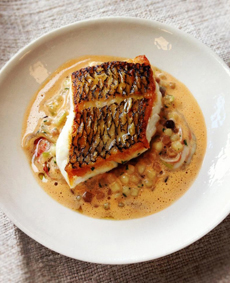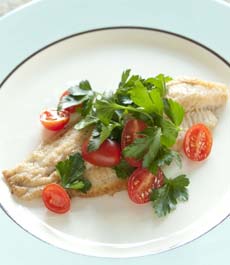TIP OF THE DAY: Ways To Cook Fish
|
Lent began yesterday, the 40-day period from Ash Wednesday to Holy Thursday (this year on April 2nd). During Lent, observers recognize Christ’s sacrifice by giving up something pleasurable. Around the world, the most common Lenten practice is to give up meat. In the U.S., seafood sales soar during the six weeks of Lent.
Whether you’re a lent observer, or simply want to eat more healthfully, here’s inspiration from GetFlavor.com, a magazine and website for professional chefs. |
It couldn’t be easier: Pan-sautéed fish topped with a light salad. Photo courtesy Whole Foods Market. |
|
|
|
||
 You can make this nicely-plated restaurant dish. Just place grilled bass or other fish atop a bed of grains or vegetables and surround with broth or sauce. In a pinch, you can make a sauce from a can of creamed soup. Photo courtesy Chef Scott Conant. |
BOILING, POACHING OR STEAMING: THE DIFFERENCE These three related cooking techniques are both healthful and easy. Here are the nuances: Poaching Poaching is a gentle cooking method used to simmer foods in a hot, but not boiling, liquid. Water is often used as the poaching liquid but its flavor is often enhanced with broth or stock, juice, vinegar or wine. Typically, vegetables (carrot, celery, onion), citrus (lemon, lime, orange), herbs and/or spices are added to the liquid for additional depth of flavor. Chicken breasts, eggs, fish/seafood and fruit are good candidates for poaching. Boiling is more intense than poaching. Foods are cooked in rapidly bubbling liquid, most often water. Poaching is best suited to foods such as starches and vegetables that can withstand the high heat and the agitation of rapidly moving water. Beets, broccoli, carrots, cauliflower hearty greens (collards, kale, turnip greens), pasta, potatoes and rice are some of the most frequently-boiled foods. |
|
|
Steaming With this technique, foods are cooked by steam generated from boiling liquid. Water is most often used because little to no flavor is transferred to the food from the steam. Since there’s no direct contact with water, steaming retains the shape, texture and bright color (e.g., of asparagus or other vegetables and fruits) without becoming water-logged or soggy. Steaming also prevents vitamins and minerals from dissolving into the cooking liquid. Fruits, proteins, vegetables and even desserts—cakes, custards and puddings) can be steamed. For instructions on each of these techniques, visit CampbellsKitchen.com.
|
||



